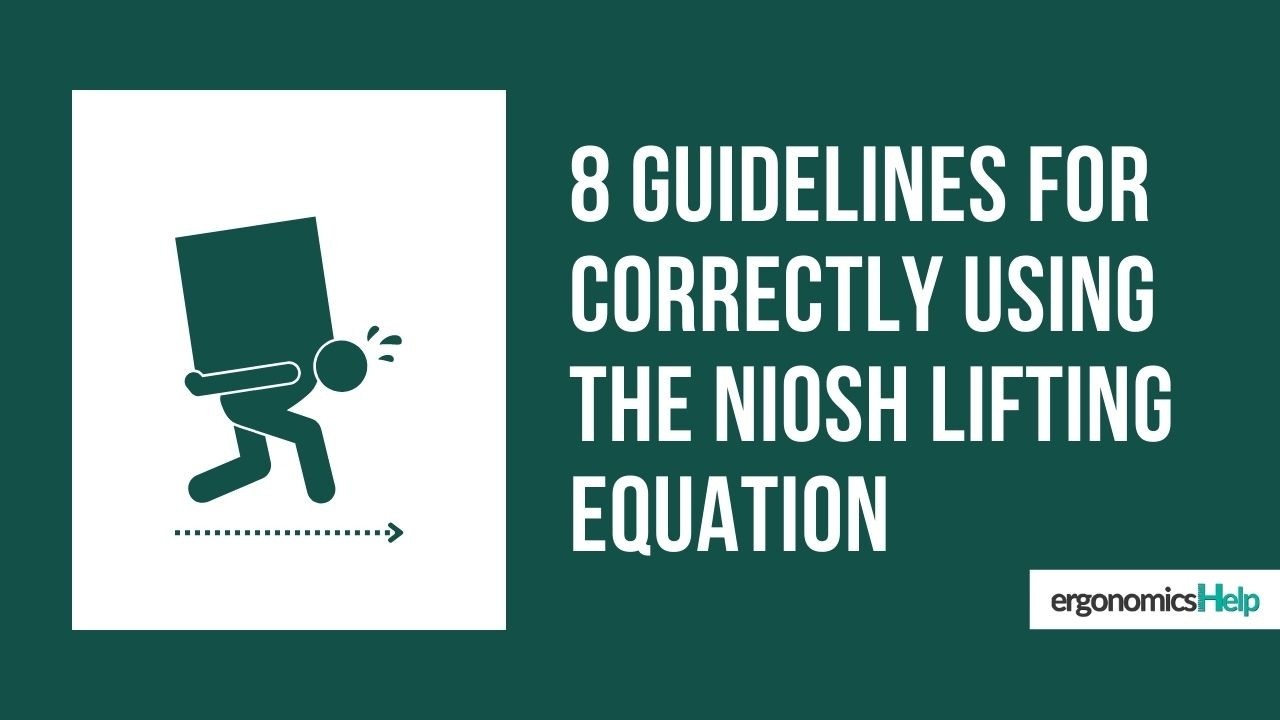8 Guidelines For Correctly Using The NIOSH Lifting Equation
Jun 09, 2022
Although technological changes have made it possible for some work environments to reduce the need for manual work, many jobs still require workers to do some manual material handling (MMH) tasks. Manual lifting tasks often expose employees to risk factors that can result in costly injuries and a decrease in productivity. Employers have a responsibility to eliminate, or at least mitigate, manual handling risks in the workplace. As Ergonomics Consultants, we can help employers reduce the incidence of MSDs resulting from manual lifting injuries and improve their operations via industrial ergonomic assessments. Using the appropriate risk assessment tool and knowing how to apply them allows us to increase the validity of our assessments and helps us provide the best recommendations.
The NIOSH Lifting Equation is the widely used tool used for assessing manual material handling and is considered the gold standard. In this post, I’m going to share with you the guidelines for the design and assessment of manual lifting tasks. These are simple approaches that you can use when consulting to a variety of workplaces that still require their workers to do some heavy lifting.
Why It’s Important to Reduce Manual Handling Risks
Manual material handling (MMH) refers to any activity that requires physical exertion, such as lifting, lowering, pushing, pulling, and carrying tasks. These tasks are most common in industrial settings like manufacturing and warehousing—where employees are exposed to these types of loads more often—but are present in almost all working environments. Even when handling light loads, the risk of manual handling injury still happens if the task is repetitive and done in poor conditions.
MMH contributes to a large percentage of the over half a million cases of musculoskeletal disorders (MSDs) reported annually in the United States, according to NIOSH. Back injuries account for 1 of every 5 injuries in the workplace. According to the Bureau of Labor Statistics (BLS), 80% of these injuries happen to the lower back and are related to manual materials handling tasks. It’s also reported that MMH accounts for 30% to 40% of the workers' compensation claims in the United States. And if employers don't address the root cause, MSDs will progress over time, resulting in direct and indirect costs for the organization. Given the prevalence and economic impact of MSDs resulting from lifting tasks, it should be clear why preventing manual handling injuries in the workplace is vital.
Certainly, the best solution to help prevent these injuries is to refrain workers from performing such tasks. However, in some businesses, significant manual handling activities are still needed. Therefore, when manual handling of loads in the workplace can’t be eliminated, employers should introduce control measures to prevent injuries from happening. As an Ergonomic Consultant, this is a great opportunity for you to provide ergonomic services via industrial ergonomics.
The NIOSH Lifting Equation
If we look at the world of workers’ compensation claims and accommodations, there’s a lot of need for industrial ergonomics. To have risk-free and safer workplaces, employers in the industrial setting want and need ongoing access to somebody with ergonomics expertise. It's for the fact that manual material handling in industrial types of settings is the next logical step for those Ergonomics Consultants who want to expand their revenue. If you’re also looking to jump into industrial ergonomics, knowing which tool is most appropriate to use is important.
The National Institute of Occupational Safety and Health (NIOSH) has produced various documents and tools to help industries establish their own ergonomics program. A widely used tool is the NIOSH Lifting Equation, which is used to predict the risk of lifting-related injuries. It's all pretty clear. However, when many ergonomics service providers are just starting out, it can feel confusing and overwhelming to properly select tools like the NIOSH lifting equation. This is why I wanted to share a few important pieces of information about this tool, so you can avoid making mistakes. The NIOSH lifting equation is not a simple tool to use due to some of the details you must observe and it can only be used in certain parameters.
When to use the NIOSH Lifting Equation:
The NIOSH Lifting Equation is the right tool to use when, for example:
- you’re assessing two-handed, manual lifting and lowering tasks (you're not looking at pushing, pulling, carrying, shoveling, or pushing a wheelbarrow).
- the workers are standing while doing the tasks (not in a seated or kneeling posture)
- the task duration is no more than eight hours a day
- the load is compact and stable
- there’s enough room in the workspace (not in a constrained or restricted workspace)
- there’s a temperate environment of about 70 degrees Fahrenheit or about 21 Celsius
- you're evaluating a job that’s repetitive and with low to moderate speed of lifting.
- there’s good floor coefficient of friction or good foot-to-floor contact
The NIOSH Lifting Equation is backed by various literature. Analyzing the 8 scenarios above can help you determine optimal lifting conditions and improvements to recommend that will reduce the MMH risk factors for the task. If the task that you’re looking at doesn’t meet the eight criteria above, then you must use another ergonomics risk assessment tool.
And that’s it! The correct selection of ergonomic risk assessment tools gives Ergonomics Service Providers a more viable way of addressing injury risk factors when conducting industrial ergonomic risk assessments. The NIOSH Lifting Equation is really useful and it captures the major ergonomic hazards. Applying this information is exactly what Accelerate: The Business of ergonomics program does. If you’re looking to expand your career, maybe offering ergonomics assessments as a side-hustle or as a new entrepreneurial journey, then I want to encourage you to join me in the new webinar. This webinar is going to be incredibly valuable for you. Just head here to sign up.
